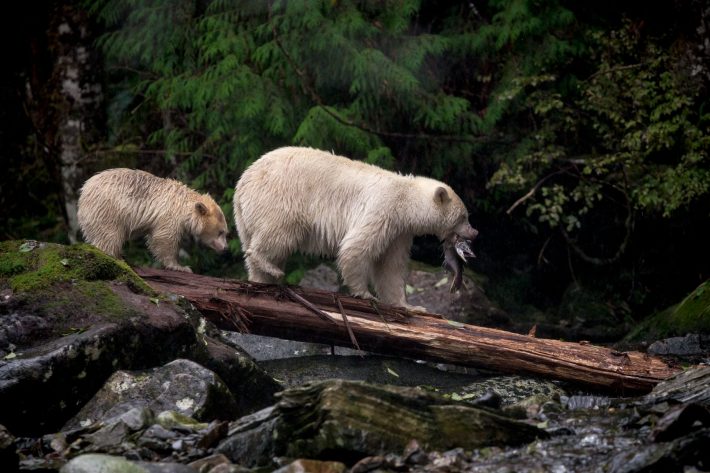New study reveals rarity of the Spirit Bear and gaps in their protection in the Great Bear Rainforest
University of Victoria press release.
New research has identified that the small genetic change responsible for Spirit bears – a rare, white-coated form of black bears – is up to 50% rarer in the Great Bear Rainforest than previously estimated. The study also indicates that geographic hotspots, where the Spirit bear version of the gene was especially prominent lack adequate protection from resource extraction.

The study by Scientists and stewardship practitioners from the Kitasoo/Xai’xais and Gitga’at First Nations, the University of Victoria, Spirit Bear Research Foundation and Raincoast Conservation Foundation was published today in the peer reviewed and open access journal, Ecological Solutions and Evidence.
Dr. Christina Service, Wildlife Biologist for the Kitasoo/Xai’xais Stewardship Authority and researcher with Spirit Bear Research Foundation, Raincoast and UVic, led the team that mapped the carriers of the ‘Spirit bear’ version of the gene – the ‘switch’ that when inherited from both parents gives black bears a white ‘Spirit Bear’ coat. The study analysed DNA collected from hair samples from 385 black bears across 18,000 km2 in coastal British Columbia’s “Great Bear Rainforest”.
“We found that the frequency of the white version of the gene was as much as 50% lower compared with previous estimates. While ongoing work is estimating the number of Spirit Bears in the area, such a finding questions previous estimates”, said Service. The work also revealed that ~50% of the ‘hotspots’ where the Spirit bear version of the gene was especially prominent were not protected by parks and protected areas.
For Douglas Neasloss, Resource Stewardship Director for the Kitasoo/Xai’xais Nation and co-author, these results carry weight. His community of Klemtu has invested in a conservation-based economy that relies heavily on bear viewing, especially Spirit bears. He states “Given my community’s cultural and economic connection to Spirit bears, it is not an exaggeration to say that our well-being is directly related to the well-being of these bears. It is critical we find avenues to attend to these gaps in protection”.
Simone Reece, Director of Gitga’at’s Oceans and Lands Department agrees, as the Gitga’at have forgone short-term economic opportunities in important Spirit bear habitats such as logging to advance habitat protection and low-impact bear-viewing. Simone observes: “Our territory is the heart of Spirit bear habitat and we have worked successfully to protect critical areas. These findings confirm our ongoing efforts for further protection to ensure the well-being of this amazing species and of our community.”
These findings inform contemporary land use planning, which include the potential for increased protection in the form of Indigenous Protected Areas.
You can read the paper for free here:
Service CN, Bourbonnais M, Adams MS, et al. Spatial patterns and rarity of the white-phased ‘Spirit bear’ allele reveal gaps in habitat protection. Ecol Solut Evidence. 2020;e12014. https://doi.org/10.1002/2688-8319.12014
Press contacts
Lead author: Dr. Christina Service, PhD (University of Victoria), Biologist with Kitasoo Xai’xais Stewardship Authority, Raincoast Conservation Foundation and Spirit Bear Research Foundation, christina.service@gmail.com, 1-250-580-7302 (cell).
Co-author: Douglas Neasloss, Kitasoo/Xai’xais First Nation, Kitasoo/Xai’xais Stewardship Authority, Stewardship Director, dougneasloss@gmail.com, 1-604-354-5989 (cell).
Andrew Frank, Gitga’at First Nation, Public Relations Officer, andrew@andrewfrank.com, 1-604-367-2112 (cell).
Like what we stand for?
Support our mission and help develop the next generation of ecologists by donating to the British Ecological Society.